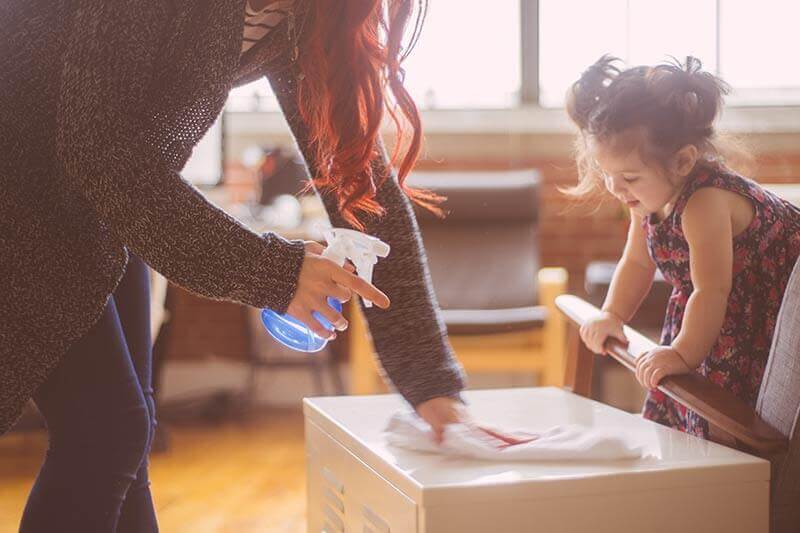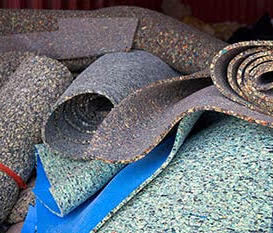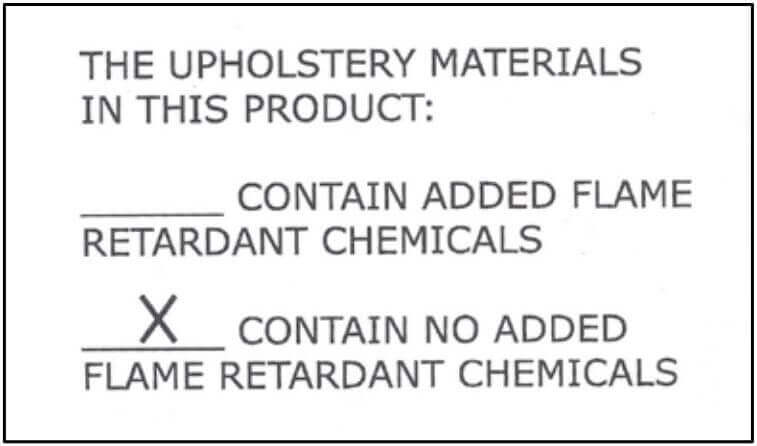Consumer Resources
This page contains information on what you can do at home and when you shop to reduce exposure to toxic chemicals.

How can I reduce my exposure to harmful chemicals in my home?
- Use HEPA filters when vacuuming.
- Dust with wet cleaning cloths and use a wet mop.
- Change filters on heating and cooling units frequently.
- Maintain proper ventilation (e.g., open windows on days with good outdoor air quality).
- Wash hands frequently, especially before eating.
- Avoid purchasing products that contain harmful chemicals (see below).
- Get rid of older furniture that may contain flame retardants.
How can I find products without harmful chemicals?
Apparel
- Clothing and shoes advertised as water-resistant or stain-resistant may have PFAS chemicals. Check out our list of PFAS-free apparel, outdoor gear, and shoes.
- Avoid clothing advertised as “antimicrobial”, “antibacterial”, or “anti-odor”.
Building insulation
- Avoid foam plastic insulation (polystyrene, polyisocyanurate, and polyurethane insulation), which contains flame retardants.

Carpets and rugs
- Older carpets and rugs may contain PFAS for stain- and soil-repellency. Check out our list of PFAS-free carpets and rugs.
- Avoid using rebonded carpet padding made from recycled or scrap polyurethane foam, which may contain flame retardants.
Children’s products
- Children’s products manufactured before 2015 may contain flame retardants added to the foam. These older products may have a TB 117 label.
- Most car seats contain flame retardants in the foam.
- Some car seats contain PFAS for stain- and soil-repellency. Check out our list of PFAS-free car seats.
- Avoid inexpensive metal jewelry or charms, which may contain cadmium or lead.
Cleaning products
- Avoid products that are advertised as “antimicrobial” or “antibacterial.” Note that many soap brands are replacing antimicrobials like triclosan and triclocarban with problematic quats (e.g., benzalkonium chloride, benzethonium chloride) or chemicals with limited information on health impacts (e.g., chloroxylenol).
- Select eco-labelled cleaning products, such as the U.S. EPA’s “Safer Choice”.

Furniture
- Furniture manufactured before 2015 may contain added flame retardants. Look for a TB 117-2013 label (with wording as on right) that states whether or not furniture contains added flame retardants.
- Swap out the foam in your cushions with new flame-retardant free foam--or consider buying a new couch. See our fact sheet about buying furniture without flame retardants.
- Some furniture may contain PFAS for water- or stain-repellency. Check out our list of PFAS-free furniture.
Kitchen products
- To avoid PFAS, purchase cast iron, glass, or ceramic cookware rather than Teflon. Check out our list of PFAS-free foodware.
- Avoid plastics marked with recycle codes 3 or 7 which may be made with bisphenols or phthalates.
- Avoid older hand (immersion) blenders which may leak chlorinated paraffin flame retardants.

Paints
- Use water-based, instead of oil-based, paints.
- Don’t use epoxies and resins containing bisphenols or harsh solvents.
Personal care products (body washes, cosmetics, toothpaste, etc.)
- Avoid personal care products with “perfluor-“, “polyfluor-“, and “PTFE” on the label. Check out our list of PFAS-free personal care products.
- Avoid products that are advertised as “antimicrobial”, “antibacterial”, or “anti-odor”. Note that many personal care products are replacing antimicrobials like triclosan and triclocarban with problematic quats (e.g., benzalkonium chloride, benzethonium chloride) or chemicals with limited information on health impacts (e.g., chloroxylenol).
- Look for fragrance-free personal care products, since the ingredients “fragrance”, “perfume”, or “parfum” often mean phthalates are present.
- Do not use imported skin lightening, acne treatment, or anti-aging creams unless you are certain that they do not contain mercury.

How do I reduce exposure to toxic chemicals in my diet?
- Avoid food in contact with greaseproof packaging (which may have PFAS), such as microwave popcorn and some fast food.
- When possible, opt for glass, porcelain or stainless steel food containers and tableware, particularly for hot food or liquids. Avoid microwaving plastics.
- If your home has older faucets and pipes that may contain lead, use cold water for drinking or cooking.
- Eat more fresh food and less canned, packaged, and fast food.
- Avoid fish that are high in mercury, such as shark, swordfish, orange roughy, bluefin, and bigeye tuna (see this chart by the U.S. FDA).
- To reduce arsenic in your diet, include alternatives to rice-based foods whenever possible.
How do I reduce toxic chemicals in my drinking water?
- If you are concerned about PFAS in your drinking water, consider installing an in-home filter on your tap. EWG summarized what is known about the efficacy of the different filter options here.
- Ask your water provider if you have a lead service line providing water to your home. If you have a lead service line, ask if there are any programs to assist with removal of the lead service line going to your home.
- If lead is a concern, you can use a certified filter for all water you use for drinking or cooking.
- Many public water systems will test drinking water for residents upon request. There are also laboratories that can test for lead, PFAS, and other contaminants.